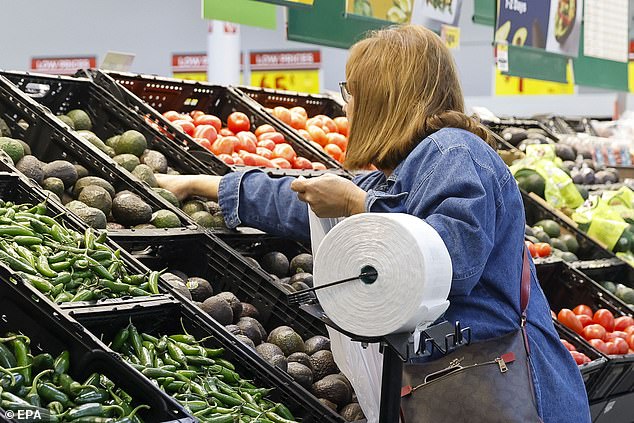Economists and consumer experts have warned which products are likely to become more expensive under Donald Trump’s new trade tariff proposals.
The president-elect has promised to impose a slew of new tariffs on foreign imports on the first day of his presidency.
Trump promised yesterday that he will impose an additional 10 percent tariff on Chinese goods through executive orders, on top of existing duties.
He also threatened 25 percent tariffs on America’s two largest trading partners, Mexico and Canada.
More than $1.3 trillion worth of goods were imported to America from the three countries last year, according to data from the US Census Bureau.
That means goods ranging from cars, gasoline, smartphones and appliances to pharmaceuticals and clothing could rise in price, experts warn.
“Tariffs will drive up costs for American businesses and those costs will ultimately work their way into higher prices for shoppers,” retail expert Neil Saunders told DailyMail.com.
“If the rates are broad, it will impact a wide range of categories. But the devices that will be most affected are appliances, furniture and clothing,” GlobalData’s Saunders explains.
Donald Trump has promised to impose tough sanctions on China, Mexico and Canada
Mexico is the US’s largest trading partner, importing $475 billion worth of goods from the country last year. The Washington Post reported.
The majority of these imports were manufactured items such as cars, computers and home appliances, which could increase in price under the proposed tariffs.
A tariff with Canada as America’s second-largest trading partner would also have widespread consequences.
The US imported more than $418 billion in goods from Canada alone last year, including crude oil and machinery such as turbines and engines.
The US also imports billions in plastics, pharmaceuticals, metals and agricultural products annually from its northern neighbor.
These items could also cause prices to rise if Trump follows through with these plans.
Canada and Mexico are also major suppliers of vehicles and parts, and many cars sold in the U.S. are assembled in those countries or use parts sourced there, according to Newsweek.
Analysts estimate a tariff could add $1,000 to $5,000 to the price of a new car, making parts such as engines and tires more expensive.
Canada and Mexico are also major exporters of agricultural products to the US.
Potential tariffs could make everyday food items like fruits, vegetables, meat and dairy more expensive, the outlet reported.
China has been a target for Trump’s tariffs as he seeks to protect that domestic vehicle and other manufacturing industries from cheaper Chinese imports.
Last year, the US imported nearly $427 billion worth of goods from China and exported nearly $148 billion, making the country the world’s third largest trading partner.
The top goods the U.S. imported from China last year were electronics, including phones, computers, toys, games, sporting goods, furniture and plastic, according to The Washington Post.
It also imports billions worth of a wide range of items such as clothing and shoes, medical equipment, chemicals and pharmaceuticals, the outlet reported, which could also rise in price.

Potential tariffs could make everyday foods like fruits, vegetables, meat and dairy more expensive

Chinese electric vehicles have been a tariff battleground for some time

The US imports billions in agricultural products from its northern neighbor every year

The US also imports billions in plastics, pharmaceuticals, metals and agricultural products every year from its northern neighbor (photo: a customer in a drugstore)

“Tariffs will drive up costs for American businesses and those costs will ultimately work their way into higher prices for shoppers,” retail expert Neil Saunders told DailyMail.com
Trump made the trade threats on his Truth Social platform, claiming that tariffs would be used to stem the flow of drugs and immigrants into the United States.
“This tariff will remain in effect until drugs, especially Fentanyl, and all illegal aliens stop this invasion of our country!” he said of Mexico and Canada.
He also reported that he had “had many conversations with China regarding the massive amounts of drugs, particularly Fentanyl, being sent to the United States – but to no avail.”
Trump has continued to debate various tariffs throughout his presidential campaign and since his election victory.
During his campaign, he proposed a 60 percent tariff on all Chinese goods, in addition to a blanket tax on all other imports into the country.
It is not known which of his proposals will actually be adopted in January.
But before this last promise, Economists at ING had argued that the Americans would be short of money another $2,400 per year.
With further tariffs proposed on Mexican and Canadian imports, as well as on Chinese imports, this figure is likely to be even higher.
“This potential increase in consumer costs and inflation could have widespread economic consequences, especially in an economy where consumer spending accounts for 70 percent of all activity,” economists Inga Fechner and James Knightly wrote in their report.
GlobalData’s Saunders added that retailers may be able to adjust to the tariffs – if such proposals are actually implemented.
“Over time, retailers and manufacturers will change where they make things, but implementing these changes cannot be done overnight,” he told DailyMail.com.
“The one point we should not forget is that President Trump is using the threat of tariffs as a negotiating tactic.
“So there is no guarantee that tariff policy will be as harsh as the rhetoric in the long term. Still, retailers must prepare for the worst.”


